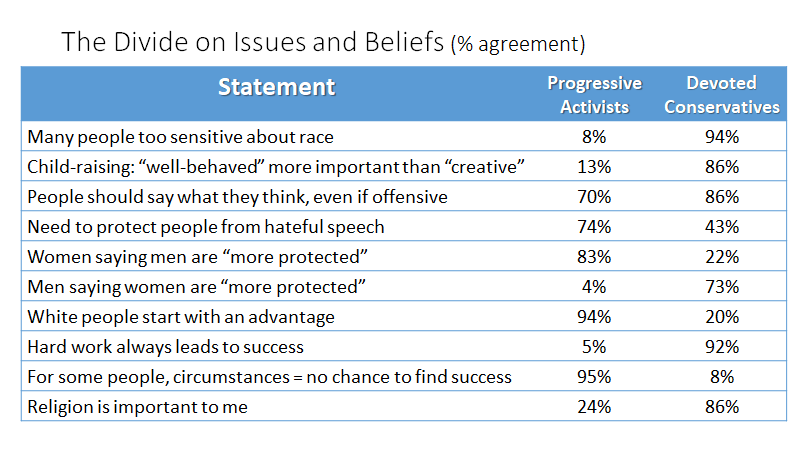Tribes
/olitical observers go to great lengths to “understand the voter”. In the process, they typically rely on traditional demographics—dividing people by age, race, gender…or by geography, religion and (someday, I assume) their personal relationship with gluten. These kinds of groupings are inevitably imprecise. After all, a “white, middle class, college-educated suburban housewife from the Midwest” may have a diametrically different idea of who should be elected governor than her demographic “twin” living just down the street.
Don’t get me wrong. The idea of demographics may be OK as far as it goes. But it doesn’t go far enough.
There’s another way. Instead of identifying “who people are”, with the normal slicing and dicing, wouldn’t it be more helpful to ask, “what people think”? And what they believe? In other words, consider that a rich, retired stockbroker in New York City and a struggling young junior college student in New Mexico may not overlap in any way demographically…but may support exactly the same candidate for President for exactly the same reasons. That would be because they see themselves—and the world—in very similar ways.
Now, of course I’m not breaking any new ground with this observation. These kinds of distinctions aren’t lost on some pollsters and many social scientists who have practiced “psychographics” for some time. They pursue this alternate path to understanding. Currently, one of the most intriguing examples is a study called, Hidden Tribes: A Study of America’s Polarized Landscape (2018). If you find the beliefs and votes of some of your fellow Americans baffling, this can go a long way to increase understanding.
So, forget about your group. Let’s explore your “tribe.”
elow I’m going to list all seven tribes identified by the authors and briefly summarize what characterizes each. But before that, it’s important to note the impact of the opposing “wings” of the voting population—the 33% total that combines both the far left and far right. It’s instructive that the study defines the “wings” as tribe #1 on the left…and both #6 and #7 on the right. In between are groups the authors call the “exhausted majority.”
hose extreme wings include people who attract the most attention from the media, because they’re the loudest and best serve the narrative need for conflict. But the focus on them is way out of whack with the voting public. Even together, these polar opposites represent a clear minority of the voting population—only a third of America. Do you stand in one of these wings? Or, put another way, do you love every single thing that Donald Trump does? Or conversely, do you believe America is broken, and demands radical-left surgery? Either way, two out of three voters disagree with you.
According to the study, in between these wings are four categories that range from the Politically Disengaged to many who normally consider themselves highly motivated voters—but who right now have had enough. Polarization has worn them down. They ask, “can’t we just get along?”
In descriptive form, ranging from left to right politically, here are the tribes (with the percentage of the total electorate each represents). To start, we’ll identify them in terms of general demographics and issues…and leave their deeper beliefs for a little later:
Progressive Activists (8%). They are younger, angrier, more cosmopolitan and more highly engaged. Issue-wise, they’re motivated by race, inequality and climate change.
Traditional Liberals (11%). More likely to be older and retired, both rational and cautious, and open to compromise. For them, the divisions in society are particularly troubling. They care about leadership…and are highly opposed to Donald Trump.
Passive Liberals (15%). These people are not happy; in the words of the authors, “insecure, distrustful, disillusioned.” They are much more likely to say things have gotten worse for them over the last year. More likely than average to be female, young or black. When they focus on issues at all, it’s on racism, healthcare and poverty.
Politically disengaged (26%). They’re mainly young and decidedly detached, believing that our differences are too big to heal. Any “booming” economy has left them behind. They consider themselves patriotic and are more prone to entertain conspiracy theories. But few will vote.
Moderates (15%). They are engaged, middle-of-the-road--and pessimistic. Their main issues are the divisions in society, foreign tensions and healthcare.
Traditional Conservatives (19%). Middle class and religious, with a high self-professed concern for morals and patriotism. They’re focused on foreign tensions, terrorism and jobs. Twice as likely to approve of Donald Trump’s job performance, and twice as likely to watch Fox News.
Devoted Conservatives (6%). Demographically they overlap with the traditional conservatives. But their views on issues are more hardcore—far more likely to support a Muslim ban and the border wall.
Again, people on both wings combine to constitute just a third of the voting population. The four groups in the middle—two thirds of Americans—share a common yearning for unity, reflected in terms like, “meet in the middle”, “keep an open mind” and “accept (our) differences.”
But achieving that unity is a tall order when there is so much passionate disagreement about what’s wrong in our country.
ne of the beauties of this study is that it’s exhaustive—8,000 respondents. Each one completed a form measuring 58 different “core beliefs”. Then some members from each tribe also sat down for 30 hours and talked about topics ranging from American identity to social justice…from morality to personal responsibility.
And it’s by plumbing the depths of these feelings within and between tribes where the study offers the most value. Some of the findings are entirely predictable. For example, look at the following chart that details the huge divide between those on the far left and far right in terms of world view:
Most of those numbers are self-explanatory, but some of the questions in the survey posed a choice between two ideas that are related, but not entirely opposite; in other words, not clearly picking between chocolate and vanilla. For example, on the speech-related questions above, where do you draw the line between “offensive” and “hateful?” This kind of forced selection increases understanding.
Some of the results are fascinating (and to many, infuriating). Note that 73% on the far right think that our society “protects” (favors) women more than men—that men are actually at a disadvantage. (For people who ask, “how could any woman vote for Trump?”, the answer is probably buried in there somewhere.)
In that same group on the far right, one in five believes that white people hold no societal advantage.
To me, the most striking findings come when people are asked two statements about who can “make it” in America. The first says if people work hard enough, they can find success. Period. The second states that some people are born so far behind the eight ball they can never get ahead.
The “anyone can succeed” argument has the support of only 5% of Progressive Activists, while 92% of Devoted Conservatives agree. On the other hand, only 8% of Conservatives say outcomes are out of some people’s control, while 95% of Progressive Activists believe that.
In the background, you can almost hear rivals yelling: “stop whining and pull yourself up!”, versus, “you don’t understand my world!”
And predictably, there is a huge divide on religion. Only a quarter of Progressive Activists strongly say religious identity matters to them; for Dedicated Conservatives, 86% say yes.
Let’s face it. These opposing wings are never going to fly in the same direction, so why even try to reconcile those world views? Far better to move on to focus on that Exhausted Majority…those four groups in the middle.
hese two-thirds of voters don’t align on every issue, but overall they’re tired. Too much partisan reporting, social media blowback and forced conformities. It’s caused those four groups in the middle to either frequently turn away or entirely tune out. As a whole, they tend to vote, but they don’t contribute money to candidates, they don’t attend meetings and they don’t post their political thoughts on social media. They want compromise and they’re willing to be flexible:
The chasms here aren’t as wide as the issue divisions on the previous chart. But the differences are still substantial. Those on the far left and right are equally divided on whether to “fight” or “talk” more. For those in the middle of the electorate, compromise wins by a 2-to-1 margin.
And it’s also interesting to note that the middle groups here clearly lean left on many issues. They overwhelmingly see racism and sexism as big problems in America (with agreement ranging from 87% to 98% on specific points). They tend to support abortion rights and same sex marriage.
But when it comes to solutions, they are far more reserved. Over 85% oppose applying racial quotas in college admissions. More than half feel that Confederate statues are more a symbol of southern pride than racism. And half believe too many things in the workplace are being labeled sexual harassment. Thus, these voters pass no one’s ideological purity test. But they don’t care. It’s what they feel.
For those on either wing, it’s tempting to dismiss these “middle-of-the-roaders” as people who just aren’t up to speed—they need to open their eyes!
But for better or worse, these are the people who’ll decide the next election.
et’s conclude by homing in on just two groups—the Passive Liberals and the Politically Disengaged. Together, that’s 40% of all potential voters. They sit next to each other on the tribal spectrum.
The Disengaged are just that—don’t bother them, they’re out.
Meanwhile, the name Passive Liberals is perfectly descriptive. They’re liberal in basic political sentiment…but in a disturbingly passive way. This group feels isolated and alienated, seeing their lives declining within an increasingly dangerous world. They are the poorest of the seven sectors (people on both wings are the wealthiest). They don’t feel like they make any difference—and most often that they don’t even want to try. Compared to other Americans, they are 22 points less likely to be registered to vote. On the tribal spectrum, these two groups aren’t just adjacent…in one way, they seem dangerously close to overlapping. If they suffer any further sense of alienation, some of those Passive Liberals are going to slip into the ranks of the fully Disengaged and just stay home on election day. This is part of the Trump reelection playbook. For any Democratic candidate, forget the descriptor “Liberal” here--they are the furthest thing from reliable supporters.
inally, let me offer a snapshot reaction in terms of politics. In many ways, the far left is engaged in a purity passion play, with all the finesse of a Chairman Mao. If you don’t believe exactly as they do, you’re simply not worthy. And thus, this passion play could lead to an electoral crucifixion.
That’s why Biden, from the start, has been fine with appearing tone deaf to rigid identity politics and many of the radical solutions demanded by some of his rivals. He’s sidestepping them for a reason. And it’s the same reason why Buttigieg and Klobuchar are tacking toward the center…and gaining momentum.
Some candidates understand who these tribes are.
And those are the candidates who also know how to count votes.
Have a comment or thought on this? Just hit the Your Turn tab here or email us at mailbox@cascadereview.net to have your say.












